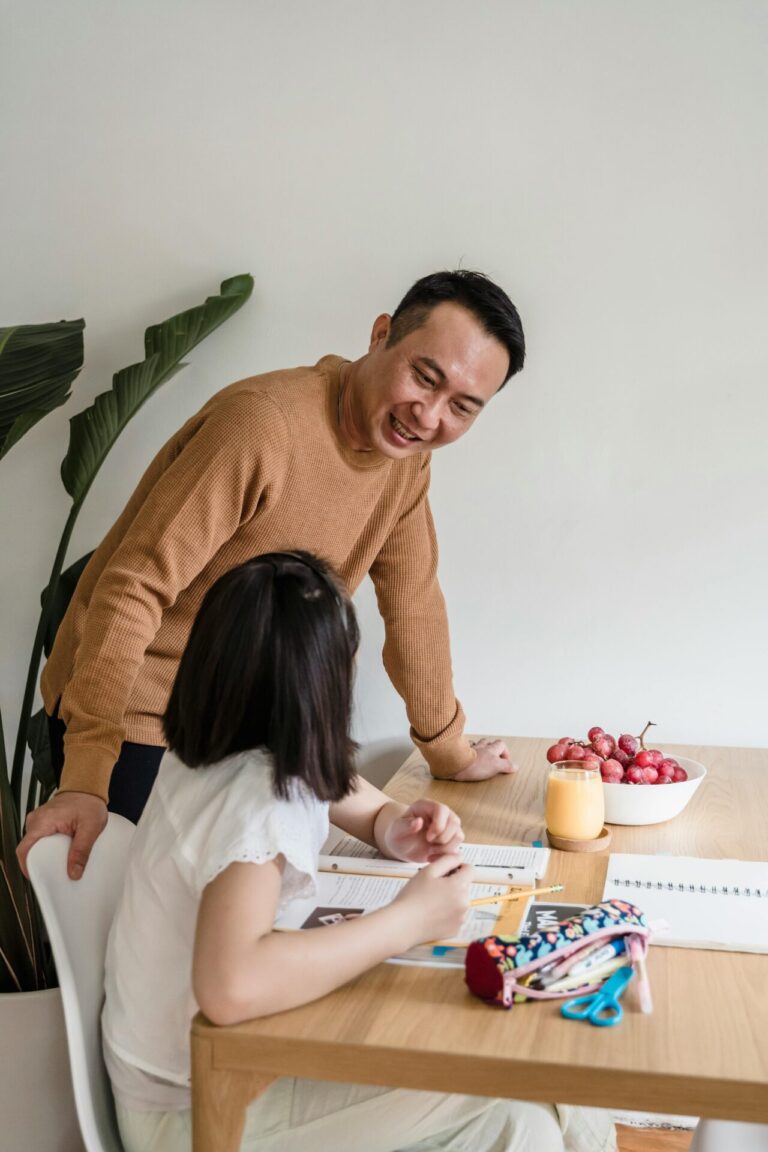Creating a Supportive Learning Routine at Home
As a parent, you know that school doesn’t end when the bell rings—learning continues at home, where homework, study sessions, and skill-building shape your child’s academic journey. But creating a home environment that fosters focus, motivation, and success can feel like a daunting task, especially when distractions like screens, siblings, or stress get in the way. A supportive learning routine can transform chaotic evenings into productive, positive experiences, helping your child thrive in school and beyond.
In this blog post, we’ll share seven practical strategies to build a supportive learning routine at home, backed by insights from educators, child psychologists, and the latest educational research. From setting up a dedicated study space to fostering independence, these tips are designed for kids from elementary to high school. With real-life examples and actionable advice, this guide will empower you to create a home learning environment that sparks success. Let’s dive in and make learning at home a breeze!
Why a Supportive Learning Routine Matters
A consistent, supportive learning routine at home does more than help with homework—it builds habits that drive academic achievement, confidence, and lifelong learning. A 2019 study in Journal of Educational Psychology found that structured home learning environments improve academic outcomes by up to 20%, particularly when routines emphasize focus and independence. Benefits include:
- Better Grades: Organized study habits lead to deeper understanding and higher test scores.
- Improved Motivation: A positive routine reduces resistance to schoolwork, fostering enthusiasm.
- Enhanced Skills: Time management, organization, and self-discipline prepare kids for future challenges.
- Reduced Stress: Clear expectations and support make learning less overwhelming for kids and parents.
Whether your child is tackling 3rd-grade math or AP Biology, a well-crafted routine sets them up for success. Here are seven strategies to make it happen.
1. Establish a Consistent Schedule
A predictable routine helps children know when it’s time to focus, reducing resistance and building habits. Consistency is key to making learning feel natural, not forced.

How to Do It
- Set a Regular Study Time: Choose a daily slot for homework or studying, like 4:30 PM after a snack or 7:00 PM after dinner. Align with your child’s energy levels—some focus best right after school, others need a break.
- Balance Flexibility and Structure: Allow wiggle room for activities (e.g., sports) but aim for 5–6 days of routine. For younger kids, 30–60 minutes daily suffices; teens may need 1–2 hours.
- Create a Family Calendar: Use a shared planner or app (e.g., Google Calendar) to track study times, due dates, and extracurriculars. Display it visibly to keep everyone aligned.
- Start Small: Begin with 15–20 minutes of focused work for younger kids, gradually increasing as they adapt.
- Involve Your Child: Let them help choose study times to boost buy-in (e.g., “Would you rather study before or after soccer?”).
Why It Helps
Consistency reduces procrastination and builds self-discipline, per Child Development (2018). A set schedule signals that learning is a priority, making it a habit.
Expert Tip: “Routines are like muscle memory,” says Emma Carter, a middle school teacher. “Once they’re set, kids dive in without a fight.”
2. Create a Dedicated, Distraction-Free Study Space
A well-designed study area signals focus time and minimizes distractions, making learning more efficient and enjoyable.
How to Do It
- Choose a Quiet Spot: Pick a low-traffic area, like a desk in their room, a dining table corner, or a home office nook. Avoid high-distraction zones (e.g., near TVs or gaming consoles).
- Stock Supplies: Keep pencils, paper, calculators, and notebooks handy to prevent interruptions. Use organizers to maintain tidiness.
- Minimize Digital Distractions: Silence phones or use apps like Forest to block social media during study time. For younger kids, remove toys from the space.
- Ensure Comfort: Provide a supportive chair, good lighting, and a clear workspace to reduce physical strain. Add a personal touch, like a favorite pen or a small plant, to make it inviting.
- Adapt for Age: Younger kids may need you nearby; teens prefer privacy but benefit from periodic check-ins.
Why It Helps
A dedicated space enhances focus and productivity, per Learning Environments Research (2020). It also psychologically separates “work” from “play,” easing transitions to study mode.
Expert Tip: “Environment shapes mindset,” says Dr. Laura Phillips, a child psychologist. “A clear space clears the mind for learning.”
3. Break Tasks into Manageable Chunks
Overwhelming assignments can make kids shut down before starting. Breaking tasks into smaller, achievable steps builds momentum and reduces stress.
How to Do It
- Prioritize Assignments: Help your child list tasks by due date or difficulty. Start with quick wins (e.g., a short worksheet) to build confidence.
- Use Time Blocks: Try the Pomodoro Technique—25 minutes of work, 5-minute break. For younger kids, 10–15 minutes works better.
- Set Micro-Goals: Divide tasks into steps (e.g., “Read one page,” “Solve three math problems”). Check off each step to visualize progress.
- Provide Guidance: For complex projects, help outline steps (e.g., research, draft, revise for an essay). Teens can do this independently with check-ins.
- Celebrate Progress: Praise or reward completed chunks (e.g., “Great job on that chapter—let’s grab a snack!”).

Why It Helps
Chunking reduces cognitive overload, per Cognitive Psychology (2017). Small successes boost confidence and motivation, making big tasks feel doable.
Expert Tip: “Break it down to build them up,” says Zoe Miller, a tutor. “Kids thrive when tasks don’t feel like mountains.”
4. Foster a Growth Mindset
A child who believes effort leads to improvement is more likely to embrace learning challenges. Fostering a growth mindset helps them see schoolwork as an opportunity, not a threat.
How to Do It
- Praise Effort, Not Results: Say, “I’m proud of how hard you worked on that problem,” not “You’re so smart.” Emphasize persistence over innate ability.
- Normalize Mistakes: Share your own errors (e.g., “I messed up a work task but learned from it”). Frame mistakes as part of growth.
- Use “Yet”: If they say, “I can’t do this,” add, “You can’t do it yet, but we’ll figure it out together.”
- Highlight Progress: Show improvements (e.g., “Your spelling tests went from 70% to 85%!”) to prove effort pays off.
- Model Resilience: Let them see you tackle challenges (e.g., learning a new skill) and discuss how practice helps.
Why It Helps
A growth mindset boosts resilience and motivation, per Mindset by Carol Dweck (2006). Kids who see learning as a journey are less likely to give up.
Expert Tip: “Mindset fuels effort,” says Dr. Sanjay Patel, an educational psychologist. “Teach kids that struggle means growth.”
5. Encourage Active Learning Strategies
Passive studying—like re-reading notes—yields limited results. Teaching active learning techniques, like quizzing or summarizing, enhances retention and engagement.
How to Do It
- Use Active Recall: Encourage self-quizzing (e.g., cover notes and recall key facts) or flashcards (e.g., Quizlet) for subjects like science or history.
- Practice Spaced Repetition: Review material at intervals (e.g., 1 day, 3 days, 1 week) to cement memory. Apps like Anki can help.
- Summarize or Teach: Ask your child to explain concepts in their own words or “teach” you (e.g., “What’s photosynthesis?”). This deepens understanding.
- Incorporate Variety: Mix methods—videos (e.g., Khan Academy), games (e.g., BrainPOP), or hands-on activities (e.g., building models)—to keep it engaging.
- Guide, Don’t Solve: Ask questions like “What’s the first step?” instead of giving answers to foster problem-solving.
Why It Helps
Active learning improves retention by 30%, per Psychological Science (2013). Engaging methods make studying effective and fun, reducing resistance.
Expert Tip: “Active beats passive,” says Sarah Lee, a high school teacher. “Kids learn best when they’re doing, not just reading.”
6. Support Well-Being and Balance
A stressed, tired, or overscheduled child struggles to focus. Prioritizing well-being—through rest, play, and emotional support—fuels their ability to learn.
How to Do It
- Ensure Sleep: Aim for 9–11 hours for elementary kids, 8–10 for teens, per Sleep Foundation (2025). Sleep boosts memory and mood.
- Schedule Breaks: Include downtime for hobbies, exercise, or play. A 10-minute walk or dance break refreshes focus.
- Limit Extracurriculars: Ensure activities (e.g., sports, music) don’t overwhelm. One or two passions are often enough.
- Promote Healthy Habits: Offer nutritious snacks (e.g., fruit, nuts) and water to fuel brainpower. Limit screen time before study sessions.
- Check In Emotionally: Ask, “How’s your day going?” to gauge stress. Offer empathy and problem-solving if they’re upset.
Why It Helps
Well-being enhances cognitive function and motivation, per Journal of Child Psychology (2020). A balanced child is more ready to learn.
Expert Tip: “A happy kid learns better,” says Max Lee, a parenting coach. “Balance is the secret to focus.”
7. Build Independence and Accountability
While support is crucial, fostering independence helps kids take ownership of their learning, preparing them for future success.
How to Do It
- Teach Time Management: Show them how to use planners or apps (e.g., Todoist) to track assignments and deadlines.
- Set Goals Together: Help set specific, achievable goals (e.g., “Finish 10 math problems today”). Teens can set their own with guidance.
- Encourage Self-Assessment: Ask, “How do you think you did on this?” to build critical thinking. Guide them to check work (e.g., verify math solutions).
- Establish Consequences: Agree on outcomes for skipped work (e.g., no gaming until homework’s done), but let them manage the process.
- Celebrate Ownership: Praise self-initiated efforts (e.g., “I’m impressed you started your project early!”).
Why It Helps
Independence boosts intrinsic motivation and self-efficacy, per Journal of Educational Research (2018). Kids who own their learning are more engaged.
Expert Tip: “Guide, don’t control,” says Dr. Anita Chen, a pediatric psychologist. “Independence builds lifelong learners.”
Overcoming Common Challenges
Building a routine isn’t always smooth. Here’s how to tackle hurdles:
- Resistance to Routine: Start small (e.g., 10-minute study blocks) and use rewards (e.g., a favorite snack) to ease them in.
- Distractions: Enforce device-free study time and model focus by limiting your own screen use during sessions.
- Lack of Motivation: Tie learning to their interests (e.g., math for gaming stats) or set short-term goals with incentives.
- Parental Stress: Stay calm during conflicts; take breaks if tensions rise. Parenting groups or coaches can offer support.
- Time Constraints: Prioritize key tasks if schedules are tight, and use weekends for catch-up.
Pro Tip: Keep a weekly log of study times and progress to spot patterns and adjust the routine as needed.
Maximizing Your Learning Routine
To make your routine thrive, try these tips:
- Involve Teachers: Ask for insights on your child’s needs or resources (e.g., practice worksheets) to align home efforts with school.
- Use Technology Wisely: Leverage educational apps (e.g., Duolingo, IXL) for extra practice, but monitor screen time.
- Celebrate Success: Acknowledge milestones (e.g., a B on a test) with praise or small rewards to keep motivation high.
- Adapt as Needed: Revisit the routine every 4–6 weeks to adjust for new schedules, subjects, or challenges.
- Model Lifelong Learning: Share your own learning (e.g., a new recipe) to show that growth is lifelong.
Conclusion: Build a Routine That Sparks Success

Creating a supportive learning routine at home is a powerful way to help your child excel academically and grow as a learner. By establishing a consistent schedule, designing a focused study space, breaking tasks into chunks, fostering a growth mindset, encouraging active learning, supporting well-being, and building independence, you can transform learning from a chore into an opportunity. These seven strategies, grounded in research and expert advice, work for kids tackling spelling lists or college applications.
Start small: pick one strategy, like setting a study time or creating a workspace, and build from there. Involve your child, stay patient, and celebrate progress. With a supportive routine, you’ll not only boost grades but also nurture confidence and curiosity that last a lifetime. Here’s to making home a place where learning thrives!

